When the penguins invade the Standard Model
This is a translated version of this post, written originally in Portuguese by Renan Picoreti at N-dimensional and translated by Carlos Hotta.
—————————————————————

It is not unusual to find weird names in the middle of Physic theories. Arguably, the most famous are the one given to second and third generation quarks: Charm, Strange, Bottom and Top. The last two used to be called Beauty and Truth but, truly, the new names did not exactly recovered their reputation. =P
The reader may find the names given to the quarks quite normal, or even amusing. However, I doubt that you will disagree that calling something in Physics “penguin” is pure crazyness.
When you study the decay and reactions of elementary particles, we use a series of drawings called Feynman Diagrams help the calculations. These diagrans are useful because they indicate the equations that inform us the probabiliy of decay or reation.
One of those diagrans is the Penguim Diagram, which look like this:
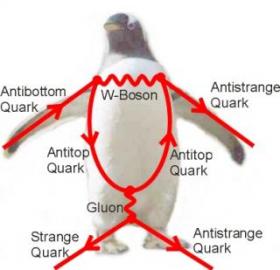
“Well – you may think – this thing really looks like a penguin, doesn´t it? Maybe a very creative physicist (like almost alll of them) gave this name due to the similarities.”
I am sorry to inform you that the story behind this name is more interesting. Everything started with John Ellis (reproduced from here by Mikhail Shifman):
“Mary K. [Gaillard], Dimitri [Nanopoulos], and I first got interested in what are now called penguin diagrams while we were studying CP violation in the Standard Model in 1976… The penguin name came in 1977, as follows.
In the spring of 1977, Mike Chanowitz, Mary K. and I wrote a paper on GUTs [Grand Unified Theories] predicting the b quark mass before it was found. When it was found a few weeks later, Mary K., Dimitri, Serge Rudaz and I immediately started working on its phenomenology.
That summer, there was a student at CERN, Melissa Franklin, who is now an experimentalist at Harvard. One evening, she, I, and Serge went to a pub, and she and I started a game of darts. We made a bet that if I lost I had to put the word penguin into my next paper. She actually left the darts game before the end, and was replaced by Serge, who beat me. Nevertheless, I felt obligated to carry out the conditions of the bet.
For some time, it was not clear to me how to get the word into this b quark paper that we were writing at the time…. Later…I had a sudden flash that the famous diagrams look like penguins. So we put the name into our paper, and the rest, as they say, is history.”
Now, my dear readers, you know that you should never underestimate the consequences of a bet among physicists.
Mikhail Shifman (1995). ITEP Lectures in Particle Physics arXiv.org DOI: arXiv:hep-ph/9510397v1
What you need to know about swine fever
This is a translated version of this post, written originally in Portuguese by Atila Iamarino at Rainha Vermelha.
What is swine fever, and why may it be so dangerous? Response in 8 steps:
1 – What is the flu virus, and what means H1N1:
2 – What is the danger of a different virus?
3 – Why is swine flu dangerous?
4 – What is the risk of a pandemic?
5 – Do we have defenses against the virus?
6 – Individual attitudes that can help.
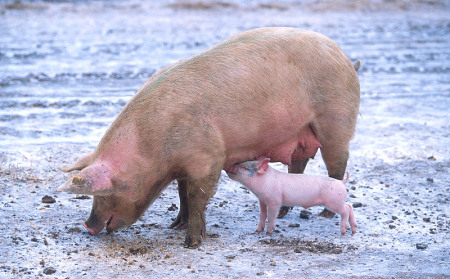
1 – What is the flu virus, and what means H1N1:
The flu is caused by a virus called influenza. There are 3 types of influenza: A, B and C. The influenza A is more variable and infects more people every year. It has 8 pieces of RNA (yes, RNA, not DNA) within its capsule. Two of its proteins are very important to understand: one is called Hemagglutinin, which is outside the virus and makes contact with the cell. Hemagglutinin has this name because when we put the virus in a drop of blood, red blood cells are agglutinated (hemo agglutinins, hemagglutinin). The other is Neuraminidase, which breaks the sugar to which hemagglutinin binds, in order to free the newly formed viruses.
Both hemagglutinin and neuraminidase are pointed outside of the virus, in consequence, these proteins are usually recognized by antibodies and used in diagnostic tests. That is why the strains of influenza are named by the letters HN, like H1N1, H3N2, according to the types of proteins.
There are 16 known types of hemagglutinin and 9 neuraminidase. Only a few are common in humans: H1, H2 and H3 and N1 and N2. All the other types are found in waterfowl, particularly ducks, that are the natural reservoir of influenza A. Migratory birds mix the virus across the world. They do not have flu symptoms and influenza infects their digestive system rather than the respiratory tract. When they stop to feed in water bodies during the migration and defecate in water, they spread the influenza. The virus may last up to 30 days in cold waters like in a lake. The most dangerous types, which kill many chickens and people when transmitted, are H5 and H7. [1]

Influenza virus electron microscopy.
2 – What is the danger of a different virus?
We lack immunity to influenza A because this virus mutates too fast [2]. Two phenomena are important: the drift, in which the virus accumulates small changes in H and N genes that, after some time, make them unrecognizable to our immune system. More importantly, and more often than thought, is the shift. The shift happens when two different influenza enter the same cell mix their genetic material, and some of the eight RNA strands comes from virus x and others comes from virus y. When this happens, the virus changes abruptly, and our immune system is completely unprepared. This is the biggest reason of vaccines fail. As there is a delay between collecting the virus and producing the vaccine, every year we have to study the virus and try to predict which group will be the most important in the epidemic.
The largest oh the recent influenza epidemics occurred when the virus rearranged between human and avian viruses, such as the 1957 Asian flu (H2N2) and Hong Kong 1968 (H3N2). The Spanish flu virus, H1N1, apparently jumped directly from ducks to humans, without any rearrangement [3]. What does intermediate the rearrangements, between human and avian viruses? Pigs and chickens.
That is why most of the influenza pandemic starts in Asia. You can easily picture popular markets crowded with people, where ducks, wild ducks, chickens, geese and pigs are sold. Another factor is how pigs are fed: they put the cage of the ducks and chickens on top of the cage of the pigs and provide food only for birds. This creates ideal conditions for the emergence of avian viruses infecting humans.
3 – Why is swine fever dangerous?
The most common virus in pigs is the H1N1. The virus that infected people in Mexico and California was sequenced by a Canadian team. It seems to be a reassortment between two pig strains: one that circulates in America and other that circulates in Europe. None of these strains is known to infect humans so there is probably little immunity to this virus in population. None of the genes come from H5N1, which caused the bird flu, or human strains.
Another worrying factor is that the current swine influenza virus has infected mostly young people. Typically, children and elderly people suffering from flu. The pattern of aggressive virus that attacks young people with the strong immune system and healthy, is a remarkable characteristic of Spanish Flu of 1918. This does not seems to be the case of swine fever, and we don’t know all the cases to see the death rate between youth.
4 – What is the risk of a pandemic?
This is not the first outbreak of Swine Flu. The largest outbreak occurred in Fort Dix, an American military camp in 1976 and taught a great lesson for the health authorities. At that time, it was expected to be a large influenza outbreak, and everything indicated that the swine flu virus was attacking the young soldiers. The pressure generated from 500 sick people and one death made wrong decisions to be taken, and there was a mass vaccination in the U.S. with drastic consequences. I recommend reading the book The incoming Plague, by Laurie Garrett, who explains this in details.
The point is that WHO, the main responsible for monitoring flu outbreaks around the world, does not work with “if we have an influenza pandemic”, but “when we will have”. With population size we have reached, and the ease of transportation we have today, it is very likely that a dangerous strain of influenza would cause great damage. Be the pandemic caused by avian influenza virus, swine or any other.
Here is a not so exciting part of the 10 items list on pandemic influenza from WHO:
“We are on the verge of an outbreak. All countries will be affected. The medical supplies will be inadequate. Many deaths will occur. The economic and social disruption will be enormous.”
The WHO has a world wide warning that goes from 1 to 6, 1 means all quiet, no dangerous disease and at 6 things get a little complicated, the pandemic is running loose. We are in stage 5, there is a disease being transmitted person to person in more than oneWHO region.
5 – Do we have defenses against the virus?
There are only a few antiviral drugs because, unlike bacteria, the virus uses the host cells to reproduce, leaving justa few possible targets. In the case of influenza, there are the neuraminidase inhibitors, such as Tamiflu and Amantadine, which prevent the virus to release the cell. The high mutation rate of the virus allows it to easily develop resistance to drugs, and do not know what will happen to H1N1.
The current strain is resistant to amantadine and rimantadine, but susceptible to Tamiflu.
Another defense against the flu is the vaccine. They are the most inexpensive and effective protection against the flu. The issue is the agility to develop a vaccine for the virus and distribute to population in time. And there is an order of priorities for vaccination. Key people at first, like government officials, doctors, then more susceptible people, such as elderly and children, and finally the population as a whole.
6 – Anyway, there are individual attitudes that may help:
Wash your hands thoroughly and frequently. Contrary to what we imagine, it is easier to contract the influenza with a handshake than a kiss on the face. If someone cold covers the sneezes with the hand and you handshake this person, you can put your hand in contact with eye and nose, and contract the virus. So, wash hands thoroughly and regularly, and if you get flu, cover your sneeze with a tissue and throw away.
Avoid crowds and enclosed spaces, mainly with air-conditioning. The Influenza lasts longer in the dry and cold, and a room with an air-conditioned mixes several people in conditions for the virus. [4] But remember, DON’T PANIC!
Recommended reads:
The Coming Plague: Newly Emerging Diseases in a World Out of Balance by Laurie Garret. A very throrough book that includes the 1918 spanish flu, the 1976 swine flu and some perspectives for the future.
Potter, C.W. “A history of influenza.” Journal of Applied Microbiology 91, no. 4 (2001): 572-579. DOI: /10.1111/j.1365-2672.2001.01492.x.
References (besides the links in the post):
[1] Webster, R G, W J Bean, O T Gorman, T M Chambers, e Y Kawaoka. “Evolution and ecology of influenza A viruses.” Microbiological Reviews 56, no. 1 (Março 1992): 152-179.
[2] Drake, J W. “Rates of spontaneous mutation among RNA viruses.” Proceedings of the National Academy of Sciences of the United States of America 90, no. 9 (Maio 1, 1993): 4171-4175.
[3] Reid, Ann H., Thomas G. Fanning,
Johan V. Hultin, e Jeffery K. Taubenberger. “Origin and evolution of
the 1918 “Spanish” influenza virus hemagglutinin gene.” Proceedings of the National Academy of Sciences of the United States of America 96, no. 4 (Fevereiro 16, 1999): 1651-1656.
[4] Lowen, Anice C, Samira Mubareka,
John Steel, e Peter Palese. “Influenza Virus Transmission Is Dependent
on Relative Humidity and Temperature.” PLoS Pathog 3, no. 10 (Outubro 19, 2007): e151.
Swine flu: guns, germs and steel
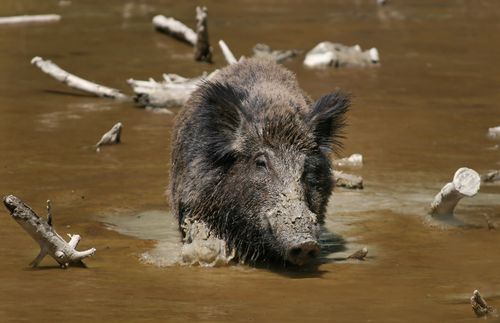
It is quite hard to think of anything other than the aporkalypse (get it?) these days (even more if you are working in real-time journalism… *sigh*). So, let’s put the hysteria to use in favor of a very important archaeological lesson: how the domestication of pigs and other animals transformed health in human societies? In many cases, to worse… Much worse.
Summarizing and simplifying things, it is almost certain that our species has to deal with rapidly spreading -and potentially deadly- infectious diseases only because it learned to breed other animals in large numbers. Flu (of course!), smallpox, whooping cough, measles, cholera, diphtheria, typhus, TB – imagine how many people died from something on that list before the development of antibiotics and modern medicine.
It just so happens that all those diseases started their “career” as zoonoses, judging by their pathogens genetic likeness with viruses or microorganisms carried by domestic animals. This hypothesis is one of the main elements of the – already classic – book “Guns, Germs and Steel”, by the american biogeographer Jared Diamond, from UCLA (hence the title of this post). You just have to look at the process the transformed wild boars (like the cute fella from the photo above) into little domestic piglets to realize that the epidemiological dynamic turned inside-out because of the domestication.
Densities, densities
First, one can hardly compare human and animal populations densities before and after domestication events. It’s true that big wild mammals such as horses, boars, sheep and cattle lived in big herds before turning into farm creatures, but rarely so many of them were confined in small space like they are now, thanks to us.
And, of course, a positive feedback happened between human and animal populations; the amount of animal protein (meats and milk), fuel (feces), fertilizer (feces once more), source material (bones) and clothes (hide) available to breeders of large mammals is exponentially superior to the amount that could be gotten by even the best hunters/gatherers. Include agriculture and you have, of course, the possibility of sustain lots more people in the same land space. Luckily, this excess people, also thanks to the animals, gets more mobile, being able to move and colonize more land on oxen, buffalo, donkeys and horseback.
Think, for a moment, how unnatural (from the point of view of 6 million years of human evolution) the situation of the last ten millennia is: the chance the hunters/gatherers had of close contact with large mammals or even flocks of birds was negligible. Oog would thank the gods if he killed one bison a month. But now you have a lot of people and a lot of animals jammed in the same settlement; people messing with manure, meat, blood, lard and who-knows-what-else from cows, pigs and goats. (The “who-knows-what-else” is not just for dramatic effect. In Papua-New Guinea, women of certain tribes breastfeed pigs. Yep, breastfeed pigs.)
This unprecedented scenario not only made disease transmission easier between humans and animals, but also helped epidemic infectious diseases to become self-sustainable for first time in our history. If you are a hunter/gatherer who is unpleasantly infected by a killer pathogen from, say, monkeys, you can rest assure in the knowledge that your whole tribe of 50 will either died completely or be totally immune, very quickly. And the disease will very likely stay there, since those 50 poor bastards rarely contact other groups.
The whole thing goes haywire when we have dense populations of breeders e growers interconnected by commercial routes and constant extra-tribal interaction. Now even killer pathogens can benefit from the population critical mass to spread from one or more entire continents and do lots and lots of damage. Something very unlikely to happen in pre-domestication times.
Winners and losers
Diamond extracts an interesting conclusion from this whole line of reason: when invading Europeans set foot in America, Polynesia and Australia for the first time, who died from smallpox, flu, measles and other Euro-asian ailments were the natives. There is not one case of a native disease killing an European settler.
None of these people domesticated animals in large scales, with the exception of Incan llamas (which are the only American big mammal [1] domesticated).
Diamond notes that, together with lower population density, lack of domestic animals is the key. The Europeans were the descendants of those who acquired immunity and survived a vast quantity of microorganisms transferred by animals that wiped out truckloads of people in Eurasia. The natives were not.
One cannot deny the conclusion taken from this is quite gloomy. Modern hygiene measures and continuous follow-up can help, but if History serves as guide, the intensive breeding of animals and intensive human contact with them will produce many more epidemic scares in the future.
[1] It has been noted – in a comment – that Andes people also domesticated guinea pigs. Besides, almost all American tribes had dogs, like many Polynesians. Nothing, however, comparable, in scale or variety, to mammals domesticated in Eurasia.
——
This is a translated version of this post, written originally in Portuguese by Reinaldo José Lopes at Chapéu, Chicote e Carbono-14 and translated by Igor Santos.
The ghost of Samuel Cartwright

Samuel A. Cartwright was a very creative physician who worked in Lousiana, south of the United States, in the mid-nineteen century and contributed with both Cholera and Yellow Fever treatments. Often called by landowners to examine sick slaves, he coined some medical terms that, as many others in medicine, ran into oblivion. Who would know, today, what could be drapetomania? And dysaethesia aethiopica?
He learnt in important medicine schools and worked with other famous physicians. But, albeit his humanistic formation, he was a slavery supporter. It’s important to notice, however, that slavery was no crime back then. Having a position for slavery was more about defending a production method than a humanist cause, unbelievable as it may seem today. Draptomania (from the greek drapetes, slave) was a word created to name a strange psychiatric disorder that afflicted slaves at the time: an unresistable and unexplainable drive to flee from their masters! Dysaethesia aethiopica (from dysaesthesia = alteration of sensitivity, and aethiop = negroid), a syndrome “described” in 1851, was also a mental disorder, proposed to explain the laziness and lack of will to work, very common among slaves and with clearly contagious characteristics! Found exclusively in blacks, was a type of skin insensitivity that compromised the mental faculties. Given its “physiopathology”, it was “cured” with ointments on the skin, followed by whipping as to stimulate cutaneous sensitivity. Pretty much the same treatment was applied to drapetomania. Apparentely with certain success.
There are at least two sides to this story: first, realise there is some blame on the doctor’s part. A certain mix of malevolence with incomprehension, still seen frequently nowadays, that would justify its actions to himself and to his peers. Here we are facing another human imprudence and the discussion ends. There is, however, a much more cruel and perverse way of understanding the story. What if we abstract our current world view and transport ourselves to the south of North America in the XIX century? Whilst trying to understand the world and Cartwright’s evidences, we could think he, in fact, didn’t do any of this for any particular hate or despise to black people. We could understand that he did so just by following the current logical and scientific presets, characteristical of the style of thinking of his time and place. Today his findings belong to the worst pseudoscience and “scientific” racism. But, back then, his diagnoses were discussed in clinical meetings!
The ghost os Samuel Cartweight should haunt doctors and medicine today. It would be useful remembering doctors that the medical practice remains and will remain, notwithstanding the evolution of scientific knowledge. That we of now may be regarded as ridiculous for someone in the future trying to understand our doubts. That we are not different of the society in which we work, and that this provokes immense black holes when we need to think about our own acts. That science is a partner and not master of our actions. I would indeed like question this ghost. I would ask the ghost of Samuel Cartwright — which is transcendent in time and space, how burlesque and pathetic are my current good intentions? Which of my attitudes will pass to history as examples of grotesque and irrational?
I sincerely hope that the ghost of Samuel Cartwright will not appear suddenly, in an afternoon, after several and extenuating consultations, in the mirror of my office.
—
This is a translated version of this post, written originally in Portuguese by Karl at Ecce Medicus. Translated by João Carlos and Igor Santos.
How governments should (not) deal with epidemics
 Brazilian government has been really concerned about swine flu. We have health agents in airports and ports to detect possible flu cases. But let’s see how it deals with Dengue, another infectious disease with a well-known life cycle, efficient prevention strategies and distinguishable symptoms.
Brazilian government has been really concerned about swine flu. We have health agents in airports and ports to detect possible flu cases. But let’s see how it deals with Dengue, another infectious disease with a well-known life cycle, efficient prevention strategies and distinguishable symptoms.
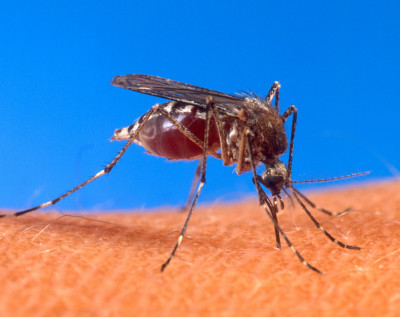
Dengue is a serious issue in Americas, with more than 850,000 cases only in 2008. Until 2007, Brazil had detected the Dengue´s serotypes 1, 2 and 3. In April, 2008 researchers found at Manaus, the largest city in Brazilian Amazon forest, Dengue virus type 4 in three patients with no history of traveling outside the city. This was a matter of great concern because serotype 4 has a low prevalence but is involved with a bigger occurrence of dengue hemorrhagic fever. [1]
However, instead of taking action, Brazilian Health Ministry made a public announcement denying that serotype 4 occurs in Brazil and has accused the laboratory of contamination, despite the fact that this laboratory does not maintain any dengue 4 virus in culture. Later, a EID publication about Amazon endemic diseases that has a Health Ministry worker (R. Glatt) as one of the authors, claimed, with no supporting reference, that:
“In September 2008, data on the isolation of DEN-4 in the Amazon region
were revised and now show that there is no evidence that this serotype
circulates in the Amazon region of Brazil.“
In April this year, some of my lab colleagues reanalyzed the dengue virus sequences with a more phylogenetic approach as the authors of the previous publication had typed the virus using BLAST, which is not the best tool to find the closest relatives of the virus.[2]
Not surprisingly, not only the results were confirmed but things got a little more interesting: they found that Dengue 4 of the genotype II (there are 3 genotypes: I, II and III) have been in America for at least 20 years as it was found in Brazil in 1982. However, the closest relative to the serotypes isolated in Manaus is the genotype I, that circulates only in Asia.
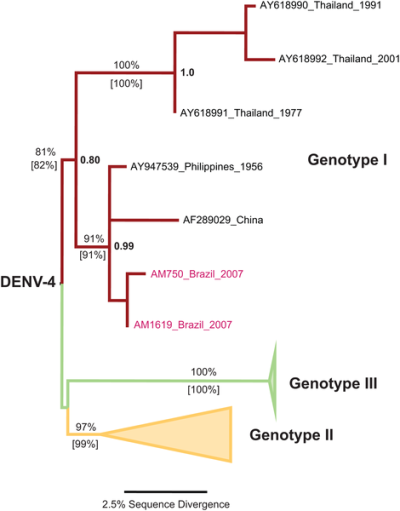
Dengue 4 phylogenetic tree with Manaus sequences in pink. Source: [2]
In conclusion, not only do we have Dengue 4 circulating in Brazil, in low frequencies (yet), but it also came from Asia! This could become a great problem to the country if the right measures are not taken.
In the year that Brazil government denied dengue 4, more than 700,000 people were infected by dengue. Up to March 2009, there have been 126,139 suspect cases, including several epidemics in a few cities in Bahia State like Jequié, where at least 5% of the population having contracted the virus.
In conclusion, instead of paying attention at science funded by itself (virtually all research done in Brazil is financed by public money), the Brazilian Health Ministry
has opted to have corporativist attitude and simply denied the
discovery. The results of this attitude are, unfortunately, human lives as we already had 23 confirmed deaths in 2009.
[1] Figueiredo, Regina Maria Pinto de, Felipe Gomes Naveca, Michele de Souza Bastos, Miriam do Nascimento Melo, Suziane de Souza Viana, Maria Paula Gomes Mourão, Cristóvão Alves Costa, e Izeni Pires Farias. “Dengue Virus Type 4, Manaus, Brazil.” Emerging Infectious Diseases 14, no. 4 (Abril 2008): 667-669.
[2] de Melo, F., Romano, C., & Zanotto, P. (2009). Introduction of Dengue Virus 4 (DENV-4) Genotype I into Brazil from Asia? PLoS Neglected Tropical Diseases, 3 (4) DOI: 10.1371/journal.pntd.0000390
—
This is a post written by Atila at Rainha Vermelha. Revised by Carlos Hotta.
How Brazil is dealing with the Swine Flu
In general, South America has not confirmed a significant amount of people with swine flu, which raises some eyebrows as it is one of the main regions that send and receive people from Mexico. Right now Brazil has 8 confirmed swine flu cases, 37 suspect cases and, curiosly, 188 cases that were dismissed as swine flu.
Of the 8 confirmed patients, 2 where infected in Brazil, from a 21-year-old that went to Cancún in his vacation and infected one of his friend and mother when he arrived. After he arrived from Mexico, he started feeling feverish, which he thought was a consequence of sun dehydration. The next day, he went to a private doctor, which concluded he had not swine flu. As the symptons persisted for another day, he decided to go to a hospital to be isolated. The young man has been released from hospital yesterday after being isolated for 10 days.
What is worrying about this story is that the patient went to a dance club after he arrived from Mexico. At the moment, Brazilian hospitals are screening for people with flu-like symptoms that have been abroad in the last 10 days. What about people that went to the same dance club as this patient?
Another worrying aspect of Brazil´s screening system is that Brazil has a significant number of flights that comes from Mexico every day, the number of people coming from Mexico has been estimated to be twice the number of people that go to UK from Mexico. However, UK has reported 71 swine flu cases and we reported 8. Are we missing people infected with swine flu in Brazil? Is there another reason for those contrasting numbers?
Flu surveillance is very deficient in Brazil as we do not know what flu virus varieties are found in the population and their infection dynamics. Add that to the incoming flu season in hemisphere and we have a lot of reasons to worry. It is possible that we will only realise the size of the problem when it is too late.
However, what scares me most is how uninformed some of our key politicians are, like São Paulo state governor, former Brazil´s Health Ministrer, that said, when the first swine flu reports arrived: “Swine flu is transmitted from little pigs to people only when they sneeze or when the person get too close to the pig´s nose.”
Brazillions and Brazillions

Welcome to the Brazillion Thoughts, the blog that contains the best texts in ScienceBlogs Brazil translated to English.
One of the reasons we have decided to become ScienceBlogs Brazil was the opportunity to bring the perspective of Brazillian scientific bloggers to the rest of the world. However we could not just start blogging in English, as our main mission is to communicate Science to Portuguese-speaking communities and automatic translators, such as the one from Google, are still not good enough to correctly translate all the subtleties and humor of our texts. Portuguese grammar seems to be particularly hard to be understood by a bot.
The solution was to make a blog in our site exclusively in English that will have translated posts from our blogs. We intent to write here the best posts from ScienceBlogs Brazil and use this blog as an useful channel to spread the qualities and problems of the Science developed here.
We hope our thoughts will be interesting to the English-speaking blogging community. We also hope our voices will be read by people from different cultural background and the discussions will be useful to show what is to be a Science enthusiast in a country like Brazil.







